LG 86UM8070PUA Schematic

CONFIDENTIAL
LED TV
SERVICE MANUAL
CHASSIS : UA92F
MODEL : 86UM8070PUA 86UM8070AUB
CAUTION
BEFORE SERVICING THE CHASSIS, READ THE SAFETY PRECAUTIONS IN THIS MANUAL.
P/NO : MFL71404408 (1903-REV00)
Any reproduction, duplication, distribution (including by way of email, facsimile or other electronic means), publication, modification, copying or transmission of this Service Manual is STRICTLY PROHIBITED unless you have obtained the prior written consent of the LG Electronics entity from which you received this Service Manual. The material covered by this prohibition includes, without limitation, any text, graphics or logos in this Service Manual.
Copyright © 2019 LG Electronics Inc. All rights reserved. Only training and service purposes.

CONTENTS
CONTENTS .............................................................................................. |
2 |
SAFETY PRECAUTIONS ........................................................................ |
3 |
SERVICING PRECAUTIONS ................................................................... |
4 |
SPECIFICATION ....................................................................................... |
6 |
SOFTWARE UPDATE ........................................................................... |
10 |
BLOCK DIAGRAM ................................................................................. |
12 |
EXPLODED VIEW .................................................................................. |
20 |
ASSEMBLY / DISASSEMBLY GUIDE.................................................... |
21 |
TROUBLE SHOOTING GUIDE ................................................ |
APPENDIX |
- 2 - |
Copyright © |
LG Electronics Inc. All rights reserved. |
|
Only for training and service purposes. |
|
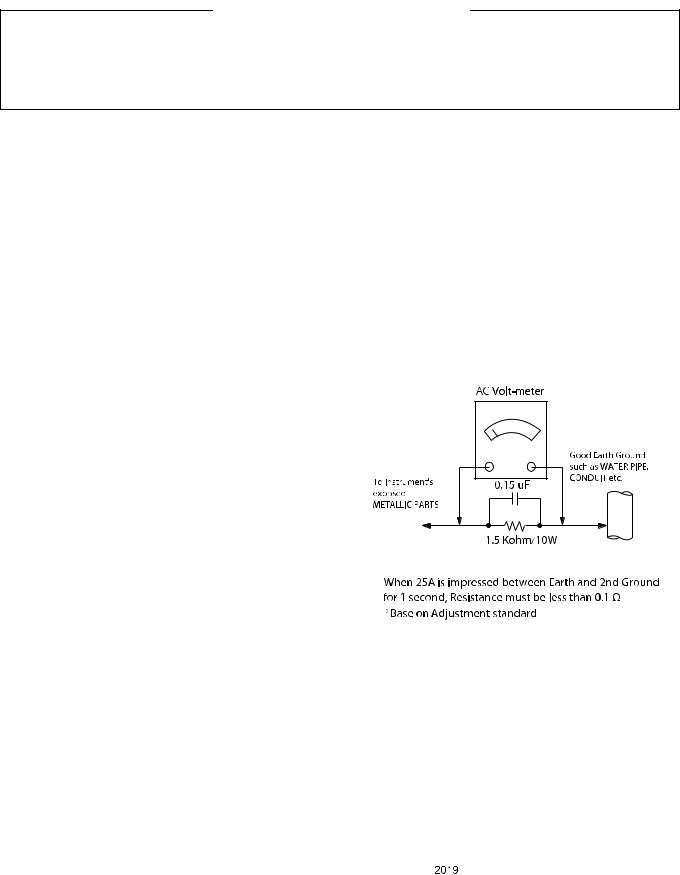
SAFETY PRECAUTIONS
IMPORTANT SAFETY NOTICE
Many electrical and mechanical parts in this chassis have special safety-related characteristics. These parts are identified by  in the Exploded View.
in the Exploded View.
It is essential that these special safety parts should be replaced with the same components as recommended in this manual to prevent Shock, Fire, or other Hazards.
Do not modify the original design without permission of manufacturer.
General Guidance
An isolation Transformer should always be used during the servicing of a receiver whose chassis is not isolated from the AC power line. Use a transformer of adequate power rating as this protects the technician from accidents resulting in personal injury from electrical shocks.
It will also protect the receiver and it's components from being damaged by accidental shorts of the circuitry that may be inadvertently introduced during the service operation.
If any fuse (or Fusible Resistor) in this TV receiver is blown, replace it with the specified.
When replacing a high wattage resistor (Oxide Metal Film Resistor, over 1 W), keep the resistor 10 mm away from PCB.
Keep wires away from high voltage or high temperature parts.
Before returning the receiver to the customer,
always perform an AC leakage current check on the exposed metallic parts of the cabinet, such as antennas, terminals, etc., to be sure the set is safe to operate without damage of electrical shock.
Leakage Current Cold Check(Antenna Cold Check)
With the instrument AC plug removed from AC source, connect an electrical jumper across the two AC plug prongs. Place the AC switch in the on position, connect one lead of ohm-meter to the AC plug prongs tied together and touch other ohm-meter lead in turn to each exposed metallic parts such as antenna terminals, phone jacks, etc.
If the exposed metallic part has a return path to the chassis, the measured resistance should be between 1 MΩ and 5.2 MΩ.
When the exposed metal has no return path to the chassis the reading must be infinite.
An other abnormality exists that must be corrected before the receiver is returned to the customer.
Leakage Current Hot Check (See below Figure) Plug the AC cord directly into the AC outlet.
Do not use a line Isolation Transformer during this check.
Connect 1.5 K / 10 watt resistor in parallel with a 0.15 uF capacitor between a known good earth ground (Water Pipe, Conduit, etc.) and the exposed metallic parts.
Measure the AC voltage across the resistor using AC voltmeter with 1000 ohms/volt or more sensitivity.
Reverse plug the AC cord into the AC outlet and repeat AC voltage measurements for each exposed metallic part. Any voltage measured must not exceed 0.75 volt RMS which is corresponds to 0.5 mA.
In case any measurement is out of the limits specified, there is possibility of shock hazard and the set must be checked and repaired before it is returned to the customer.
Leakage Current Hot Check circuit
- 3 - |
Copyright © |
LG Electronics Inc. All rights reserved. |
|
Only for training and service purposes. |
|

SERVICING PRECAUTIONS
CAUTION: Before servicing receivers covered by this service manual and its supplements and addenda, read and follow the SAFETY PRECAUTIONS on page 3 of this publication.
NOTE: If unforeseen circumstances create conflict between the following servicing precautions and any of the safety precautions on page 3 of this publication, always follow the safety precautions. Remember: Safety First.
General Servicing Precautions
1.Always unplug the receiver AC power cord from the AC power source before;
a.Removing or reinstalling any component, circuit board module or any other receiver assembly.
b.Disconnecting or reconnecting any receiver electrical plug or other electrical connection.
c.Connecting a test substitute in parallel with an electrolytic capacitor in the receiver.
CAUTION: A wrong part substitution or incorrect polarity installation of electrolytic capacitors may result in an explosion hazard.
2.Test high voltage only by measuring it with an appropriate high voltage meter or other voltage measuring device (DVM, FETVOM, etc) equipped with a suitable high voltage probe. Do not test high voltage by "drawing an arc".
3.Do not spray chemicals on or near this receiver or any of its assemblies.
4.Unless specified otherwise in this service manual, clean electrical contacts only by applying the following mixture to the contacts with a pipe cleaner, cotton-tipped stick or comparable non-abrasive applicator; 10 % (by volume) Acetone and 90 % (by volume) isopropyl alcohol (90 % - 99 % strength)
CAUTION: This is a flammable mixture.
Unless specified otherwise in this service manual, lubrication of contacts in not required.
5.Do not defeat any plug/socket B+ voltage interlocks with which receivers covered by this service manual might be equipped.
6.Do not apply AC power to this instrument and/or any of its electrical assemblies unless all solid-state device heat sinks are correctly installed.
7.Always connect the test receiver ground lead to the receiver chassis ground before connecting the test receiver positive lead.
Always remove the test receiver ground lead last.
8.Use with this receiver only the test fixtures specified in this service manual.
CAUTION: Do not connect the test fixture ground strap to any heat sink in this receiver.
Electrostatically Sensitive (ES) Devices
Some semiconductor (solid-state) devices can be damaged easily by static electricity. Such components commonly are called Electrostatically Sensitive (ES) Devices. Examples of typical ES devices are integrated circuits and some field-effect transistors and semiconductor “chip” components. The following techniques should be used to help reduce the incidence of component damage caused by static by static electricity.
1.Immediately before handling any semiconductor component or semiconductor-equipped assembly, drain off any electrostatic charge on your body by touching a known earth ground. Alternatively, obtain and wear a commercially available discharging wrist strap device, which should be removed to prevent potential shock reasons prior to applying power to the unit under test.
2.After removing an electrical assembly equipped with ES devices, place the assembly on a conductive surface such as aluminum foil, to prevent electrostatic charge buildup or exposure of the assembly.
3.Use only a grounded-tip soldering iron to solder or unsolder ES devices.
4.Use only an anti-static type solder removal device. Some solder removal devices not classified as “anti-static” can generate electrical charges sufficient to damage ES devices.
5.Do not use freon-propelled chemicals. These can generate electrical charges sufficient to damage ES devices.
6.Do not remove a replacement ES device from its protective package until immediately before you are ready to install it. (Most replacement ES devices are packaged with leads electrically shorted together by conductive foam, aluminum foil or comparable conductive material).
7.Immediately before removing the protective material from the leads of a replacement ES device, touch the protective material to the chassis or circuit assembly into which the device will be installed.
CAUTION: Be sure no power is applied to the chassis or circuit, and observe all other safety precautions.
8.Minimize bodily motions when handling unpackaged replacement ES devices. (Otherwise harmless motion such as the brushing together of your clothes fabric or the lifting of your foot from a carpeted floor can generate static electricity sufficient to damage an ES device.)
General Soldering Guidelines
1.Use a grounded-tip, low-wattage soldering iron and appropriate tip size and shape that will maintain tip temperature within the range or 500 °F to 600 °F.
2.Use an appropriate gauge of RMA resin-core solder composed of 60 parts tin/40 parts lead.
3.Keep the soldering iron tip clean and well tinned.
4.Thoroughly clean the surfaces to be soldered. Use a mall wirebristle (0.5 inch, or 1.25 cm) brush with a metal handle.
Do not use freon-propelled spray-on cleaners.
5.Use the following unsoldering technique
a.Allow the soldering iron tip to reach normal temperature. (500 °F to 600 °F)
b.Heat the component lead until the solder melts.
c.Quickly draw the melted solder with an anti-static, suctiontype solder removal device or with solder braid. CAUTION: Work quickly to avoid overheating the circuit board printed foil.
6.Use the following soldering technique.
a.Allow the soldering iron tip to reach a normal temperature (500 °F to 600 °F)
b.First, hold the soldering iron tip and solder the strand against the component lead until the solder melts.
c.Quickly move the soldering iron tip to the junction of the component lead and the printed circuit foil, and hold it there only until the solder flows onto and around both the component lead and the foil.
CAUTION: Work quickly to avoid overheating the circuit board printed foil.
d.Closely inspect the solder area and remove any excess or splashed solder with a small wire-bristle brush.
- 4 - |
Copyright © |
LG Electronics Inc. All rights reserved. |
|
Only for training and service purposes. |
|

IC Remove/Replacement
Some chassis circuit boards have slotted holes (oblong) through which the IC leads are inserted and then bent flat against the circuit foil. When holes are the slotted type, the following technique should be used to remove and replace the IC. When working with boards using the familiar round hole, use the standard technique as outlined in paragraphs 5 and 6 above.
Removal
1.Desolder and straighten each IC lead in one operation by gently prying up on the lead with the soldering iron tip as the solder melts.
2.Draw away the melted solder with an anti-static suction-type solder removal device (or with solder braid) before removing the IC.
Replacement
1.Carefully insert the replacement IC in the circuit board.
2.Carefully bend each IC lead against the circuit foil pad and solder it.
3.Clean the soldered areas with a small wire-bristle brush. (It is not necessary to reapply acrylic coating to the areas).
"Small-Signal" Discrete Transistor
Removal/Replacement
1.Remove the defective transistor by clipping its leads as close as possible to the component body.
2.Bend into a "U" shape the end of each of three leads remaining on the circuit board.
3.Bend into a "U" shape the replacement transistor leads.
4.Connect the replacement transistor leads to the corresponding leads extending from the circuit board and crimp the "U" with long nose pliers to insure metal to metal contact then solder each connection.
Power Output, Transistor Device
Removal/Replacement
1.Heat and remove all solder from around the transistor leads.
2.Remove the heat sink mounting screw (if so equipped).
3.Carefully remove the transistor from the heat sink of the circuit board.
4.Insert new transistor in the circuit board.
5.Solder each transistor lead, and clip off excess lead.
6.Replace heat sink.
Diode Removal/Replacement
1.Remove defective diode by clipping its leads as close as possible to diode body.
2.Bend the two remaining leads perpendicular y to the circuit board.
3.Observing diode polarity, wrap each lead of the new diode around the corresponding lead on the circuit board.
4.Securely crimp each connection and solder it.
5.Inspect (on the circuit board copper side) the solder joints of the two "original" leads. If they are not shiny, reheat them and if necessary, apply additional solder.
Fuse and Conventional Resistor
Removal/Replacement
1.Clip each fuse or resistor lead at top of the circuit board hollow stake.
2.Securely crimp the leads of replacement component around notch at stake top.
3.Solder the connections.
CAUTION: Maintain original spacing between the replaced component and adjacent components and the circuit board to prevent excessive component temperatures.
Circuit Board Foil Repair
Excessive heat applied to the copper foil of any printed circuit board will weaken the adhesive that bonds the foil to the circuit board causing the foil to separate from or "lift-off" the board. The following guidelines and procedures should be followed whenever this condition is encountered.
At IC Connections
To repair a defective copper pattern at IC connections use the following procedure to install a jumper wire on the copper pattern side of the circuit board. (Use this technique only on IC connections).
1.Carefully remove the damaged copper pattern with a sharp knife. (Remove only as much copper as absolutely necessary).
2.carefully scratch away the solder resist and acrylic coating (if used) from the end of the remaining copper pattern.
3.Bend a small "U" in one end of a small gauge jumper wire and carefully crimp it around the IC pin. Solder the IC connection.
4.Route the jumper wire along the path of the out-away copper pattern and let it overlap the previously scraped end of the good copper pattern. Solder the overlapped area and clip off any excess jumper wire.
At Other Connections
Use the following technique to repair the defective copper pattern at connections other than IC Pins. This technique involves the installation of a jumper wire on the component side of the circuit board.
1.Remove the defective copper pattern with a sharp knife. Remove at least 1/4 inch of copper, to ensure that a hazardous condition will not exist if the jumper wire opens.
2.Trace along the copper pattern from both sides of the pattern break and locate the nearest component that is directly connected to the affected copper pattern.
3.Connect insulated 20-gauge jumper wire from the lead of the nearest component on one side of the pattern break to the lead of the nearest component on the other side.
Carefully crimp and solder the connections.
CAUTION: Be sure the insulated jumper wire is dressed so the it does not touch components or sharp edges.
- 5 - |
Copyright © |
LG Electronics Inc. All rights reserved. |
|
Only for training and service purposes. |
|

SPECIFICATION
NOTE : Specifications and others are subject to change without notice for improvement.
1. Application range |
3. Test method |
This specification is applied to the LED TV used UA92F |
(1) Performance: LGE TV test method followed |
chassis. |
(2) Demanded other specification |
|
- Safety : CE, IEC specification |
2. Test condition |
- EMC : CE, IEC |
|
|
Each part is tested as below without special appointment. |
|
(1) Temperature: 25 °C ± 5 °C, CST: 40 °C ± 2 °C |
|
(2) Relative Humidity: 65 % ± 10 % |
|
(3) Power Voltage |
|
: Standard input voltage (AC 100-240 V~, 50/60 Hz) |
|
*Standard Voltage of each products is marked by models.
(4)Specification and performance of each parts are followed each drawing and specification by part number in accordance with BOM.
(5)The receiver must be operated for about 5 minutes prior to the adjustment.
4.General Specification
No |
|
|
Item |
|
Specification |
Remark |
|
|
|
|
|
|
|
1 |
Market |
|
|
North America |
|
|
|
|
|
|
|
|
|
2 |
Broadcasting system |
|
ATSC / NTSC-M, 64 & 256 QAM |
|
||
|
|
|
|
|
|
|
3 |
Available Channel |
|
VHF : 02~13 |
|
||
|
|
|
|
|
|
|
|
|
|
|
|
UHF : 14~69 |
|
|
|
|
|
|
|
|
|
|
|
|
|
DTV : 02-69 |
|
|
|
|
|
|
|
|
|
|
|
|
|
CATV : 01~135 |
|
|
|
|
|
|
CADTV : 01~135 |
|
4 |
Receiving system |
|
Digital : ATSC, 64 & 256 QAM |
|
||
|
|
|
|
|
Analog : NTSC-M |
|
5 |
Video Input |
|
|
NTSC-M |
Rear (1EA) |
|
|
|
|
|
|
|
|
6 |
HDMI Input |
|
UHD |
HDMI 1 |
PC / DTV format |
Side, Support 6Gbps |
|
|
|
|
|
|
|
|
|
|
|
HDMI 2 |
PC / DTV format |
Side, Support 6Gbps, Support ARC |
|
|
|
|
|
|
|
|
|
|
|
HDMI 3 |
PC / DTV format |
Rear, Support 6Gbps |
|
|
|
|
|
|
|
|
|
|
|
HDMI 4 |
PC / DTV format |
Rear, Support 6Gbps |
|
|
|
|
|
|
|
7 |
Audio Input |
|
|
AV Audio / DVI Audio |
AV and DVI use same jack ; |
|
|
|
|
|
|
|
|
8 |
SPDIF out(1EA) |
|
|
Optical Audio out |
Rear (1EA), |
|
9 |
HeadPhone |
|
|
HeadPhone out |
|
|
10 |
USB Input |
|
|
EMF, DivX HD, For SVC (download) |
JPEG, MP3, DivX HD |
|
- 6 - |
Copyright © |
LG Electronics Inc. All rights reserved. |
|
Only for training and service purposes. |
|

5. External Input Support Format
5.1. HDMI Input (PC/DTV)
No. |
Resolution |
H-freq(kHz) |
V-freq.(kHz) |
Pixel clock(MHz) |
Proposed |
Remarks |
|
PC |
|
|
|
|
|
1 |
640*350 |
31.46 |
70.09 |
25.17 |
EGA |
|
|
|
|
|
|
|
|
2 |
720*400 |
31.46 |
70.08 |
28.32 |
DOS |
|
|
|
|
|
|
|
|
3 |
640*480 |
31.46 |
59.94 |
25.17 |
VESA(VGA) |
|
|
|
|
|
|
|
|
4 |
800*600 |
37.87 |
60.31 |
40 |
VESA(SVGA) |
|
|
|
|
|
|
|
|
5 |
1024*768 |
48.36 |
60 |
65 |
VESA(XGA) |
|
|
|
|
|
|
|
|
6 |
1360*768 |
47.71 |
60.01 |
84.75 |
VESA(WXGA) |
|
|
|
|
|
|
|
|
7 |
1152*864 |
54.34 |
60.05 |
80 |
VESA |
|
8 |
1280*1024 |
63.98 |
60.02 |
109 |
SXGA |
Support to HDMI-PC |
9 |
1920*1080 |
67.5 |
60 |
158.4 |
WUXGA(Reduced |
|
|
|
|
|
|
Blanking) |
|
|
|
|
|
|
|
|
10 |
1920*1080 |
135 |
120 |
297 |
|
|
|
|
|
|
|
|
|
11 |
3840*2160 |
54 |
24 |
297 |
UDTV 2160P |
|
|
|
|
|
|
|
|
12 |
3840*2160 |
56.25 |
25 |
297 |
UDTV 2160P |
|
|
|
|
|
|
|
|
13 |
3840*2160 |
67.5 |
30 |
297 |
UDTV 2160P |
|
|
|
|
|
|
|
|
14 |
3840*2160 |
112.5 |
50 |
594 |
UDTV 2160P |
|
15 |
3840*2160 |
135 |
60 |
594 |
UDTV 2160P |
|
16 |
3840*2160 |
225 |
100 |
1188 |
UDTV 2160P |
|
17 |
3840*2160 |
270 |
120 |
1188 |
UDTV 2160P |
|
18 |
4096*2160 |
53.95 |
23.97 |
296.7 |
UDTV 2160P |
|
19 |
4096*2160 |
54 |
24 |
297 |
UDTV 2160P |
|
20 |
4096*2160 |
56.25 |
25 |
297 |
UDTV 2160P |
|
|
|
|
|
|
|
|
21 |
4096*2160 |
67.5 |
30 |
297 |
UDTV 2160P |
|
|
|
|
|
|
|
|
22 |
4096*2160 |
112.5 |
50 |
594 |
UDTV 2160P |
|
|
|
|
|
|
|
|
23 |
4096*2160 |
135 |
60 |
594 |
UDTV 2160P |
|
|
|
|
|
|
|
|
24 |
4096*2160 |
225 |
100 |
1188 |
UDTV 2160P |
|
|
|
|
|
|
|
|
25 |
4096*2160 |
270 |
120 |
1188 |
UDTV 2160P |
|
|
|
|
|
|
|
|
26 |
2560*1440 |
88.78 |
60 |
241.5 |
3K |
|
27 |
2560*1440 |
183 |
120 |
497.7 |
3K |
|
28 |
7680*4320 |
107.89 |
23.98 |
1188 |
8K |
8K Model Only |
29 |
7680*4320 |
108 |
24 |
1188 |
8K |
8K Model Only |
30 |
7680*4320 |
110 |
25 |
1188 |
8K |
8K Model Only |
31 |
7680*4320 |
131.87 |
29.97 |
1188 |
8K |
8K Model Only |
32 |
7680*4320 |
132 |
30 |
1188 |
8K |
8K Model Only |
|
|
|
|
|
|
|
33 |
7680*4320 |
220 |
50 |
2376 |
8K |
8K Model Only |
|
|
|
|
|
|
|
34 |
7680*4320 |
263.74 |
59.94 |
2376 |
8K |
8K Model Only |
|
|
|
|
|
|
|
35 |
7680*4320 |
264 |
60 |
2376 |
8K |
8K Model Only |
|
|
|
|
|
|
|
- 7 - |
Copyright © |
LG Electronics Inc. All rights reserved. |
|
Only for training and service purposes. |
|

No. |
Resolution |
H-freq(kHz) |
V-freq.(kHz) |
Pixel clock(MHz) |
Proposed |
Remarks |
|
|
DTV |
|
|
|
|
|
|
1 |
640*480 |
31.46 |
59.94 |
25.12 |
SDTV 480P |
|
|
2 |
640*480 |
31.5 |
60 |
25.12 |
SDTV 480P |
|
|
3 |
720*480 |
15.73 |
59.94 |
13.5 |
SDTV, DVD |
Spec. out but display |
|
|
|
|
|
|
480I(525I) |
|
|
4 |
720*480 |
15.75 |
60 |
13.51 |
SDTV, DVD |
|
|
|
|
|
|
|
480I(525I) |
|
|
5 |
720*576 |
15.62 |
50 |
13.5 |
SDTV, DVD |
|
|
|
|
|
|
|
576I(625I) 50Hz |
|
|
6 |
720*480 |
31.47 |
59.94 |
27 |
SDTV 480P |
|
|
7 |
720*480 |
31.5 |
60 |
27.02 |
SDTV 480P |
|
|
8 |
720*576 |
31.25 |
50 |
27 |
SDTV 576P |
|
|
9 |
1280*720 |
44.96 |
59.94 |
74.17 |
HDTV 720P |
|
|
10 |
1280*720 |
45 |
60 |
74.25 |
HDTV 720P |
|
|
11 |
1280*720 |
37.5 |
50 |
74.25 |
HDTV 720P |
|
|
12 |
1920*1080 |
28.12 |
50 |
74.25 |
HDTV 1080I |
|
|
|
|
|
|
|
|
|
|
13 |
1920*1080 |
33.72 |
59.94 |
74.17 |
HDTV 1080I |
|
|
|
|
|
|
|
|
|
|
14 |
1920*1080 |
33.75 |
60 |
74.25 |
HDTV 1080I |
|
|
|
|
|
|
|
|
|
|
15 |
1920*1080 |
26.97 |
23.97 |
63.29 |
HDTV 1080P |
|
|
|
|
|
|
|
|
|
|
16 |
1920*1080 |
27 |
24 |
63.36 |
HDTV 1080P |
|
|
|
|
|
|
|
|
|
|
17 |
1920*1080 |
33.71 |
29.97 |
79.12 |
HDTV 1080P |
|
|
|
|
|
|
|
|
|
|
18 |
1920*1080 |
33.75 |
30 |
79.2 |
HDTV 1080P |
|
|
19 |
1920*1080 |
56.25 |
50 |
148.5 |
HDTV 1080P |
|
|
20 |
1920*1080 |
67.43 |
59.94 |
148.35 |
HDTV 1080P |
|
|
21 |
1920*1080 |
67.5 |
60 |
148.5 |
HDTV 1080P |
|
|
22 |
1920*1080 |
112.5 |
100 |
297 |
HDTV 1080P |
|
|
23 |
1920*1080 |
134.86 |
119.88 |
296.7 |
HDTV 1080P |
|
|
24 |
1920*1080 |
135 |
120 |
297 |
HDTV 1080P |
|
|
|
|
|
|
|
|
|
|
25 |
3840*2160 |
53.95 |
23.98 |
296.7 |
UDTV 2160P |
|
|
|
|
|
|
|
|
|
|
26 |
3840*2160 |
54 |
24 |
297 |
UDTV 2160P |
|
|
|
|
|
|
|
|
|
|
27 |
3840*2160 |
56.25 |
25 |
297 |
UDTV 2160P |
|
|
|
|
|
|
|
|
|
|
28 |
3840*2160 |
61.43 |
29.97 |
296.7 |
UDTV 2160P |
|
|
|
|
|
|
|
|
|
|
29 |
3840*2160 |
67.5 |
30 |
297 |
UDTV 2160P |
|
|
|
|
|
|
|
|
|
|
30 |
3840*2160 |
112.5 |
50 |
594 |
UDTV 2160P |
When HDMI1,2,3,4 |
|
|
|
|
|
|
|
UHD DEEP COLOUR |
|
31 |
3840*2160 |
134.86 |
59.94 |
593.4 |
UDTV 2160P |
||
ON |
|||||||
32 |
3840*2160 |
135 |
60 |
594 |
UDTV 2160P |
||
|
|||||||
33 |
3840*2160 |
225 |
100 |
1188 |
UDTV 2160P |
|
|
34 |
3840*2160 |
270 |
120 |
1188 |
UDTV 2160P |
|
|
35 |
4096*2160 |
53.95 |
23.98 |
296.7 |
UDTV 2160P |
|
|
36 |
4096*2160 |
54 |
24 |
297 |
UDTV 2160P |
|
|
|
|
|
|
|
|
|
|
37 |
4096*2160 |
56.25 |
25 |
297 |
UDTV 2160P |
|
|
|
|
|
|
|
|
|
|
38 |
4096*2160 |
61.43 |
29.97 |
296.7 |
UDTV 2160P |
|
|
|
|
|
|
|
|
|
|
39 |
4096*2160 |
67.5 |
30 |
297 |
UDTV 2160P |
|
|
|
|
|
|
|
|
|
- 8 - |
Copyright © |
LG Electronics Inc. All rights reserved. |
|
Only for training and service purposes. |
|

No. |
Resolution |
H-freq(kHz) |
V-freq.(kHz) |
Pixel clock(MHz) |
Proposed |
Remarks |
|
|
|
|
|
|
|
|
|
|
DTV |
|
|
|
|
|
|
|
|
|
|
|
|
|
|
40 |
4096*2160 |
112.5 |
50 |
594 |
UDTV 2160P |
When HDMI1,2,3,4 |
|
|
|
|
|
|
|
UHD DEEP COLOUR |
|
41 |
4096*2160 |
134.86 |
59.94 |
593.4 |
UDTV 2160P |
||
ON |
|||||||
|
|
|
|
|
|
||
42 |
4096*2160 |
135 |
60 |
594 |
UDTV 2160P |
||
|
|||||||
|
|
|
|
|
|
|
|
43 |
4096*2160 |
225 |
100 |
1188 |
UDTV 2160P |
|
|
|
|
|
|
|
|
|
|
44 |
4096*2160 |
270 |
120 |
1188 |
UDTV 2160P |
|
|
|
|
|
|
|
|
|
|
45 |
2560*1440 |
88.78 |
60 |
241.5 |
3K |
non-standard |
|
|
|
|
|
|
|
|
|
46 |
2560*1440 |
183 |
120 |
497.7 |
3K |
non-standard |
|
|
|
|
|
|
|
|
|
47 |
7680*4320 |
107.89 |
23.98 |
1188 |
8K |
8K Model Only |
|
|
|
|
|
|
|
|
|
48 |
7680*4320 |
108 |
24 |
1188 |
8K |
8K Model Only |
|
|
|
|
|
|
|
|
|
49 |
7680*4320 |
110 |
25 |
1188 |
8K |
8K Model Only |
|
|
|
|
|
|
|
|
|
50 |
7680*4320 |
131.87 |
29.97 |
1188 |
8K |
8K Model Only |
|
|
|
|
|
|
|
|
|
51 |
7680*4320 |
132 |
30 |
1188 |
8K |
8K Model Only |
|
|
|
|
|
|
|
|
|
52 |
7680*4320 |
220 |
50 |
2376 |
8K |
8K Model Only |
|
|
|
|
|
|
|
|
|
53 |
7680*4320 |
263.74 |
59.94 |
2376 |
8K |
8K Model Only |
|
|
|
|
|
|
|
|
|
54 |
7680*4320 |
264 |
60 |
2376 |
8K |
8K Model Only |
|
|
|
|
|
|
|
|
- 9 - |
Copyright © |
LG Electronics Inc. All rights reserved. |
|
Only for training and service purposes. |
|
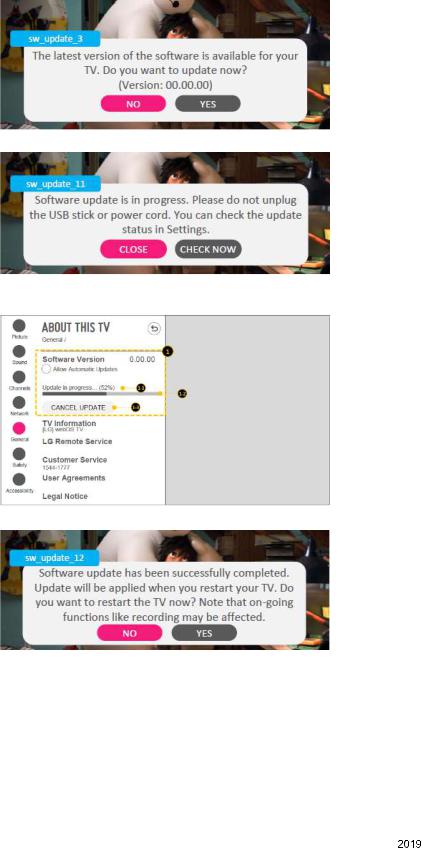
SOFTWARE UPDATE
1.USB
(1)Insert the USB memory Stick to the USB port
(2)Automatically detect the SW Version and show the below message
(3) Click [YES]: initiate the download and install of the update.
(4)Click [Check Now]: move to “About This TV” page for update
(5)TV is updating
(6) After finished the update, below Pop-up appear
(7)Click [Yes] : TV will be DC OFF -> ON
(8)After TV turned on, Check the updated SW Version and Tool Option
- 10 - |
Copyright © |
LG Electronics Inc. All rights reserved. |
|
Only for training and service purposes. |
|
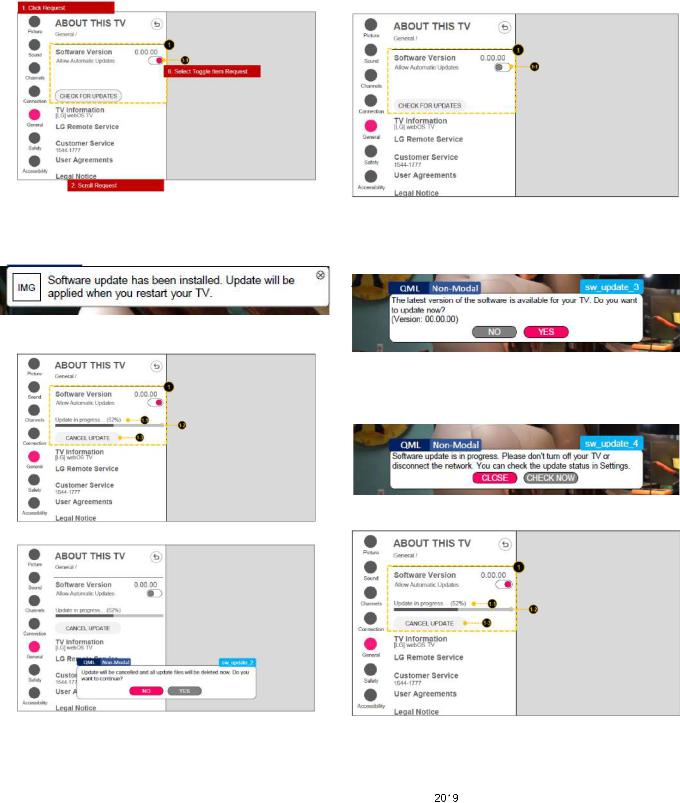
2. NSU
(This Function is needed to connect to the internet)
(Case 1) Allow Automatic Updates Toggle Item
(1) Menu -> All Settings -> General -> About This TV
(2) Silent Update_Pop-up
When the download and install of the update is complete, the TV issues a Toast notification letting the user know that the update is complete and a reboot is required.
(3)If you want to see the update progress, go to [Menu -> All Settings -> General -> About This TV]
(4) If you want to cancel update, click (1.1) CANCEL UPDATE
(5)[NO] : Keep updating [Yes] : Cancel updating
(Case 2) NOT Allow Automatic Updates Toggle Item
(1) Menu -> All Settings -> General -> About This TV
(2)TV will automatically check for updates when every TV boots
When an updated is detected, the TV will issue an Alert letting the user know that an update is available.
(3)[Yes] : Initiate the download and install of the update [No] : Close the pop-up. The Alert will come back again when TV checks again.
(4)The following pop up window appears.
(5)[CHECK NOW] : Go to the About this TV setting page [CLOSE] : Close the pop-up
- 11 - |
Copyright © |
LG Electronics Inc. All rights reserved. |
|
Only for training and service purposes. |
|
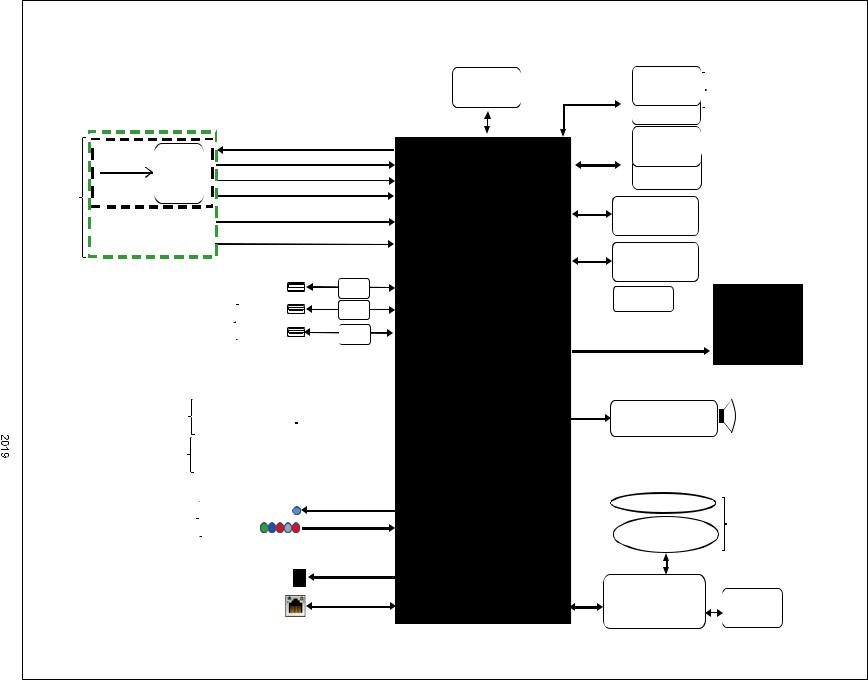
.reserved rights All .Inc Electronics LG © Copyright - 12 - .purposes service and training for Only
|
|
|
X_TAL |
|
DDR3 2640 |
Depend on Region |
|
Depend on Region |
|
24MHz |
|
512MB |
|
|
|
|
|
512MB |
|
|
|
|
|
|
|
|
|
|
|
|
I2C 5 |
M0 |
DDR3 / 2640 |
|
|
|
IF+, IF- |
512MB |
|
||
|
|
|
|
|||
|
|
|
M1 |
|
|
|
R |
|
SIF |
|
512MB |
|
|
|
|
|
|
|||
E |
|
CVBS |
|
|
|
|
A |
|
|
|
|
EEPROM(NVRAM) |
|
R |
US |
I_P, I_N, Q_P, Q_N |
|
I2C 4 |
|
|
|
(256Kb) |
|
||||
|
|
|
|
|
|
|
|
P_TS(Korea / Japan / China) |
|
|
|
|
|
|
|
|
|
|
eMMC |
|
|
KR |
|
|
|
(4GB) |
|
|
Side USB1 (2.0) |
OCP |
USB2_0 |
|
PMIC |
|
|
USB2 (2.0) |
OCP |
USB2_2 |
|
|
|
|
|
|
|
|||
|
Rear |
|
|
|
|
|
|
USB3 (2.0) |
OCP |
USB2_1 |
EPI/ |
|
|
|
|
|
Main IC |
|
|
|
|
|
|
Vx1 |
|
|
|
|
|
|
Output |
|
|
|
Side
Rear
HDMI1 HDMI 2.0
HDMI2(ARC) HDMI 2.0 HDMI3 HDMI 2.0 HDMI4 HDMI 2.0

 PHY3_RX0N
PHY3_RX0N

 PHY2_RX0N
PHY2_RX0N

 PHY1_RX0N
PHY1_RX0N 
 PHY0_RX0N
PHY0_RX0N
Depend on Region |
RS232C/HP |
|
|
CVBS/COMP |
YPbPr AV |
||
|
|||
|
OPTIC |
SPDIF OUT |
|
|
LAN |
ETHERNET |
I2S Out |
MAIN Audio AMP |
I2C 0 |
(NTP7519) |
USB_WIFI 
|
|
SUB |
|
|
|
ASSY |
|
|
Sub Micom |
X_TAL |
|
I2C 1 |
(RENESAS |
||
R5F100GEAFB) |
32.768KHz |
||
|
IC Main .1
DIAGRAM BLOCK
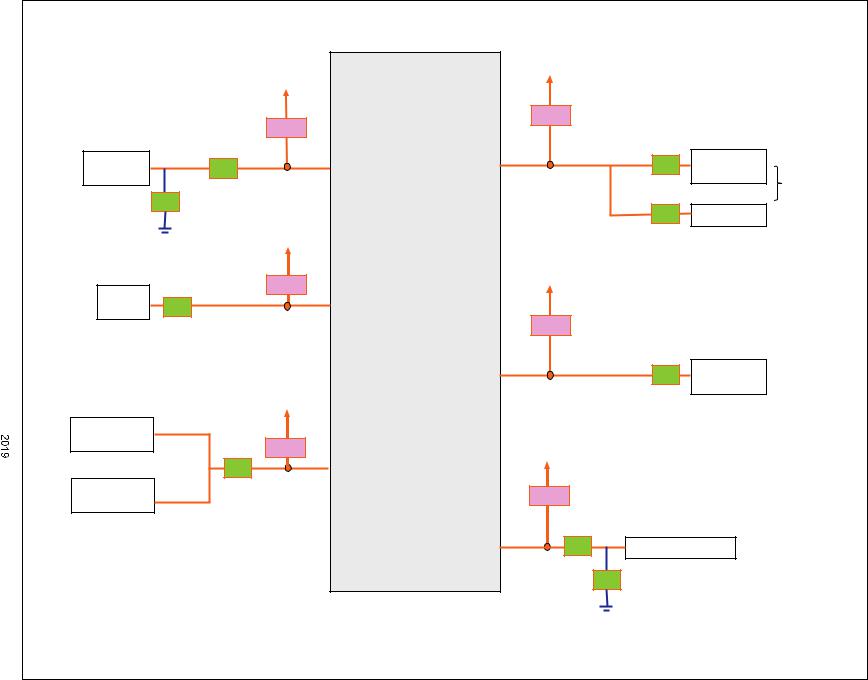
|
|
|
|
|
|
+3.3V_NORMAL |
|
I2C .2 |
|
|
|
|
|
|
|
|
|
|
|
|
|
+3.3V_NORMAL |
Main IC |
|
|
|
|
|
|
|
|
|
|
|
|
|
|
|
|
3.3KΩ |
|
2.7KΩ |
|
Depend on Region |
|
|
|
|
|
|
|
||
|
IC5300 |
|
100Ω |
SCL0 |
SCL3 |
|
33Ω |
IC7001 |
|
NTP7519 |
|
SDA0 |
SDA3 |
|
|
LNB |
|
|
|
|
|
|
||||
|
|
|
|
|
|
|
||
|
|
33pF |
|
|
|
|
33Ω |
TUNER(JAPAN) |
|
|
|
|
|
|
|
||
|
|
|
|
+3.3V_NORMAL |
|
|
|
|
|
|
|
|
3.3KΩ |
|
+3.3V_NORMAL |
|
|
|
|
|
|
|
|
|
|
|
|
IC3000 |
33Ω |
|
SCL1 |
|
|
|
|
|
MICOM |
|
SDA1 |
|
|
|
|
|
|
|
|
|
|
3.3KΩ |
|
|
|
- |
|
|
|
|
|
|
|
|
- 13 |
|
|
|
|
|
|
|
|
|
|
|
|
|
SCL4 |
|
33Ω |
IC102 |
© Copyright training for Only |
|
|
|
|
|
|
NVRAM |
|
|
|
|
|
SDA4 |
|
|
||
|
|
|
|
|
|
|
||
|
|
|
+3.3V_NORMAL |
|
|
|
|
|
IC8100 |
|
|
|
|
|
|
|
|
RT5094 |
|
|
3.3KΩ |
|
+3.3V_TU |
|
|
|
All .Inc Electronics LG .purposes service and |
|
|
|
SCL2 |
|
|
|
|
|
|
33Ω |
|
|
|
|
||
|
|
SDA2 |
|
|
|
|
||
IC8000 |
|
|
|
|
|
|
||
|
|
|
|
1.8KΩ |
|
|
||
SW50212 |
|
|
|
|
|
|
||
|
|
|
|
|
|
|
||
|
|
|
|
SCL5 |
33Ω |
TUNER |
|
|
|
|
|
|
SDA5 |
|
|||
|
|
|
|
|
|
|
||
|
|
|
|
|
|
|
|
|
.reserved rights |
|
|
|
|
|
|
47pF |
|
|
|
|
|
|
|
|
|
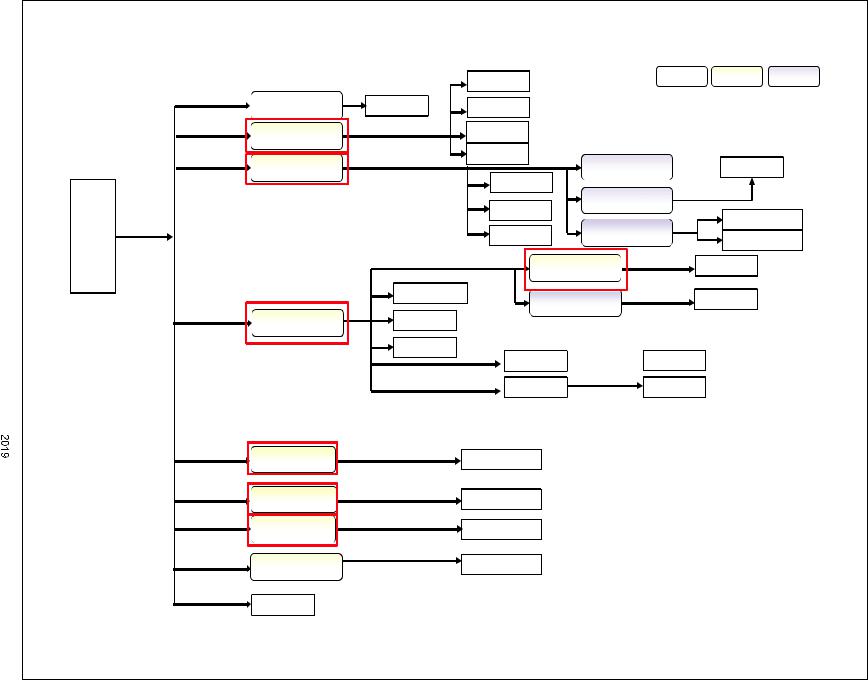
.reserved rights All .Inc Electronics LG © Copyright - 14 - .purposes service and training for Only
IC1100 |
PANEL |
|
TPS259271 |
||
|
||
|
+5V_NORMAL |
|
|
+3.3V_NORMAL |
+D13V
+3.5V_ST MAX3232CDR
MICOM
IR_KEY
+0.9V_DDR & C4TX
+1.8V_IO
+0.9V_CPU
+0.9V_CORE
IC2000 / 12A TPS56C215RNNR
NTP7519 Main
USB1 (2.0) |
|
SWITCH |
DCDC |
LDO |
USB1 (2.0) |
|
|
|
|
USB2 (2.0) |
|
|
|
|
CI_CAM |
|
1.1/1.2V_DEMOD |
|
|
|
IC6900 / 2A |
TUNER |
|
|
|
|
|
||
|
TJ4320GDP-ADJ |
|
||
NTP7519 |
|
|
||
|
IC6800 / 2A |
|
|
|
|
|
|
|
|
NVRAM |
TJ4320GDP-ADJ |
|
|
|
|
|
Main |
|
|
|
|
IC2300 / 2A |
|
|
H/P AMP |
|
|
|
|
TJ4320GDP-ADJ |
Source |
|
||
|
IC1501 / 3.5A |
1.2V_DDR |
DDR3 |
|
|
TLV62585 |
|
|
|
|
|
|
|
|
|
IC1502 / 1A |
2.5V_VPP |
DDR3 |
|
|
LR1801G-ADJ |
|
|
|
+3.5V_WOL |
ETHERNET |
|
|
|
WIFI_EN |
WIFI |
|
|
|
Main
Main
+0.9V_CPU
+0.9V_CORE
Power .3
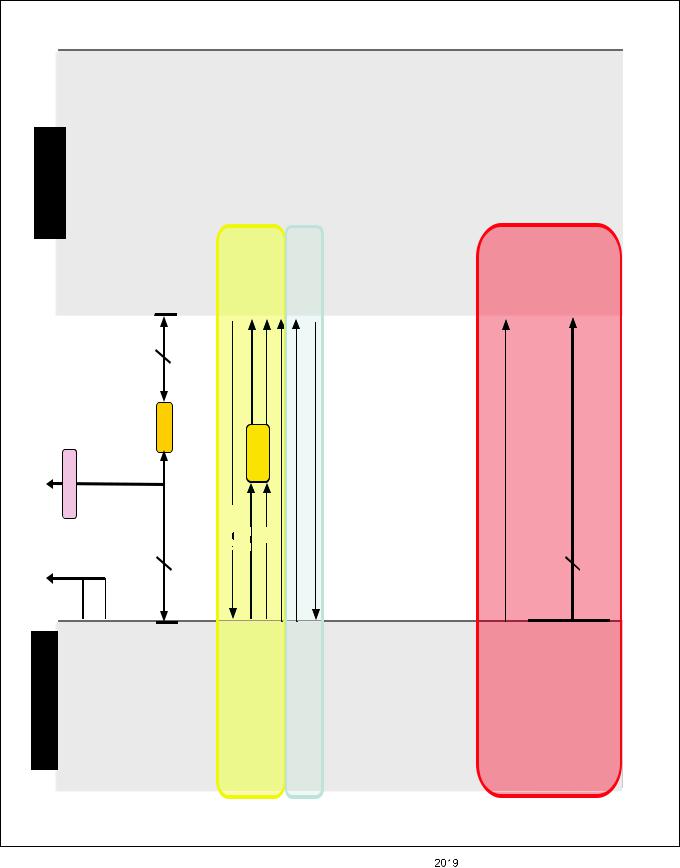
4. Tuner
Main IC
SDA5
SCL5
+3.3V TU |
1.2K |
|
33 |
KR |
COMON |
US |
+1.2V TU |
|
|
|
|
|
|
Tuner |
B2[+3.3V DEMOD]11 |
B1[+3.3V RF]3 |
[SCL RF] 1 [SDA RF] 2 |
|
[IF AGC] 5 |
|
- 15 - |
Copyright © |
LG Electronics Inc. All rights reserved. |
|
Only for training and service purposes. |
|

.reserved rights All .Inc Electronics LG © Copyright - 16 - .purposes service and training for Only
Main IC
Jack Side |
SoC Side |
JK3401
AV1_CVBS_IN_SOC
AV_CVBS_IN / AV_L_IN / AV_R_IN  CVBS_IN2
CVBS_IN2
COMP1_Y_IN_SOC
Y1_IN
Tuner
TU_SIF_TU, IF_P/N_TU |
TU_SIF, TADC_I_INN/INP |
AAD_ADC_SIF, DMD_TADC_INP, DMD_TADC_INN |
|
|
In Video/Audio .5
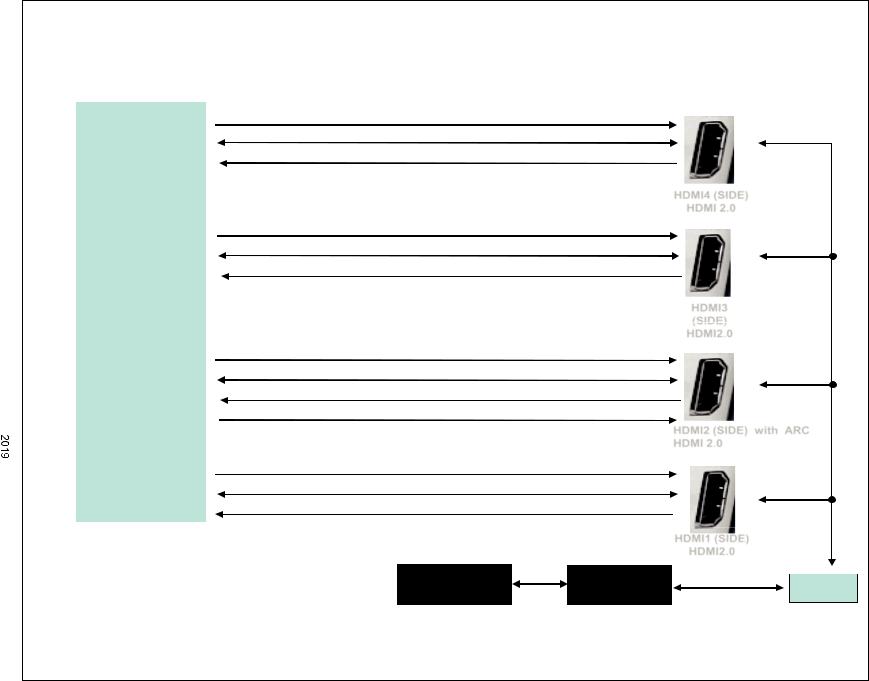
.reserved rights All .Inc Electronics LG © Copyright - 17 - .purposes service and training for Only
DDC_SCL_4
DDC_SDA_4
DDC_SCL_3
DDC_SDA_3
Main IC
DDC_SCL_2
DDC_SDA_2
PHY0_ARC_OUT
DDC_SCL_1
DDC_SDA_1
DDC_SCL_4
DDC_SDA_4 TMDS Link 8bits
DDC_SCL_3 DDC_SDA_3 TMDS Link 8bits
DDC_SCL_2
DDC_SDA_2 TMDS Link 8bits HDMI_ARC
DDC_SCL_1
DDC_SDA_1 TMDS Link 8bits
X-Tal(X3000) |
|
RENESAS |
32.768kHz |
|
MICOM(IC3000) |
|
|
|
* TMDS Link 8bits = TMDS DATA 6bits(DATA0,1,2)+ TMDS CLK 2bits
JK3104
HDMI4 (SIDE)
HDMI 2.0
JK3103
HDMI3 (SIDE)  HDMI2.0
HDMI2.0
HDMI2 (SIDE) with ARC HDMI 2.0
JK3101
HDMI1 (SIDE)
HDMI2.0
Q3001
HDMI_CEC_MICOM
HDMI .6
REMOTE_CEC
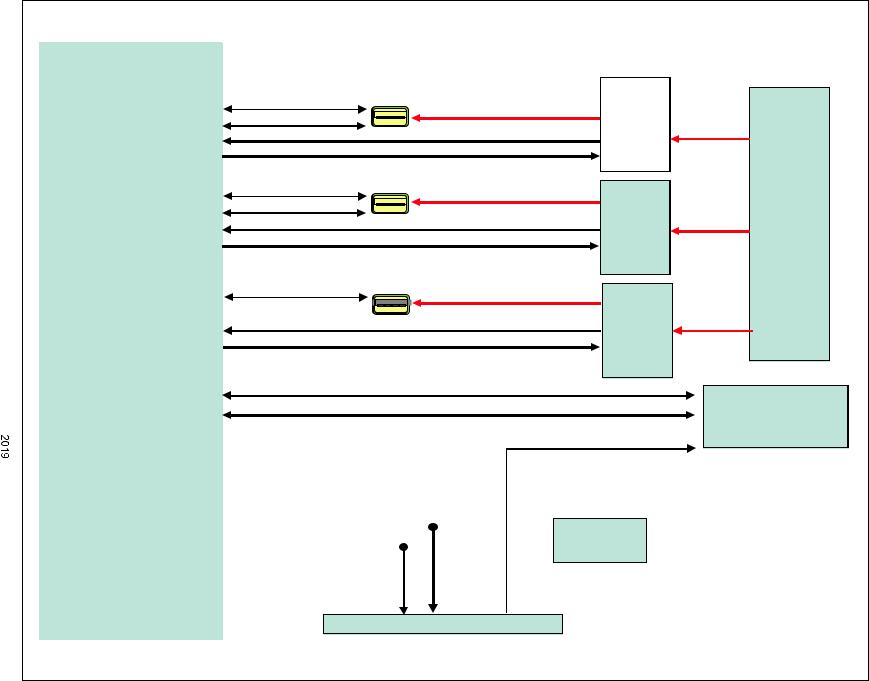
.reserved rights All .Inc Electronics LG © Copyright - 18 - .purposes service and training for Only
Main IC
USB2.0_1_DM0
USB2.0_1_DP0
USB2.0_2_DM1
USB2.0_2_DP1
USB2.0_3_DM0
USB2.0_3_DP0
USB2_2_DM0
USB2_2_DP0
UART0_TXD/GPIO105 UART0_RXD/GPIO106
/USB_OCD2
USB_CTL 2
/USB_OCD2 USB_CTL2
/USB_OCD2 USB_CTL2
WIFI_DM
WIFI_DP
SOC_TX
SOC_RX
USB2.0 |
|
|
|||
|
USB1(SIDE) +5V_USB_1 |
OCP |
|
||
|
|
|
IC4700 |
+5V_NORMAL |
|
JK4200 |
|||||
|
|
|
BD2242G |
|
|
USB2.0 |
|
|
|||
|
|
||||
USB2(SIDE) +5V_USB_2 |
|
|
|||
|
|
|
OCP |
IC1600 |
|
JK4400 |
|||||
IC4501 |
+5V_NORMAL SYVL86A |
||||
|
|
|
BD2242G |
5V / 6A |
|
USB2.0
USB3(Rear) +5V_USB_3
 JK4600 OCP
JK4600 OCP
IC4700 BD2242G
BT_RESET
BT_WAKEUP_DEVICE
BT_WAKEUP_HOST
 IC7200
IC7200  MAX3232CDR
MAX3232CDR
RENESAS MICOM(IC3000)
+5V_NORMAL
WIFI Combo
UART / REMOTE-M / WIFI / USB .7
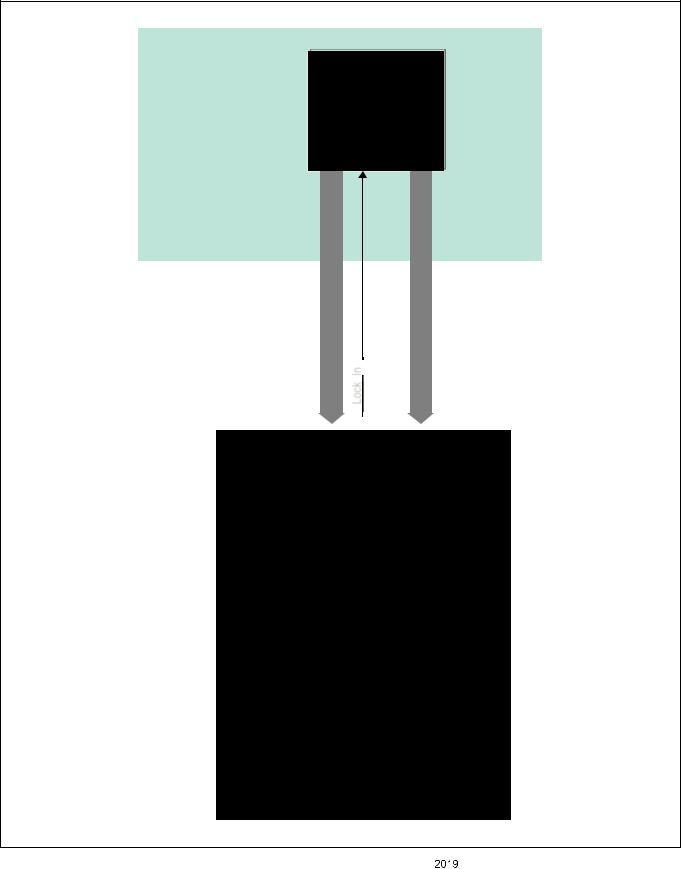
8. Vx1 41/51Pin Interface
|
|
Main Main IC |
|||||
P7601 (51p) |
|
|
|
|
|
|
P7602 (41p) |
|
|
|
|
|
|
||
|
|
|
|
|
|
|
|
|
8lane |
|
|
|
|
8lane |
|
|
TX |
|
|
|
|
TX |
|
|
|
|
|
|
|
||
|
|
Lock In |
|
|
|
|
|
|
|
|
|||||
- 19 - |
Copyright © |
LG Electronics Inc. All rights reserved. |
|
Only for training and service purposes. |
|
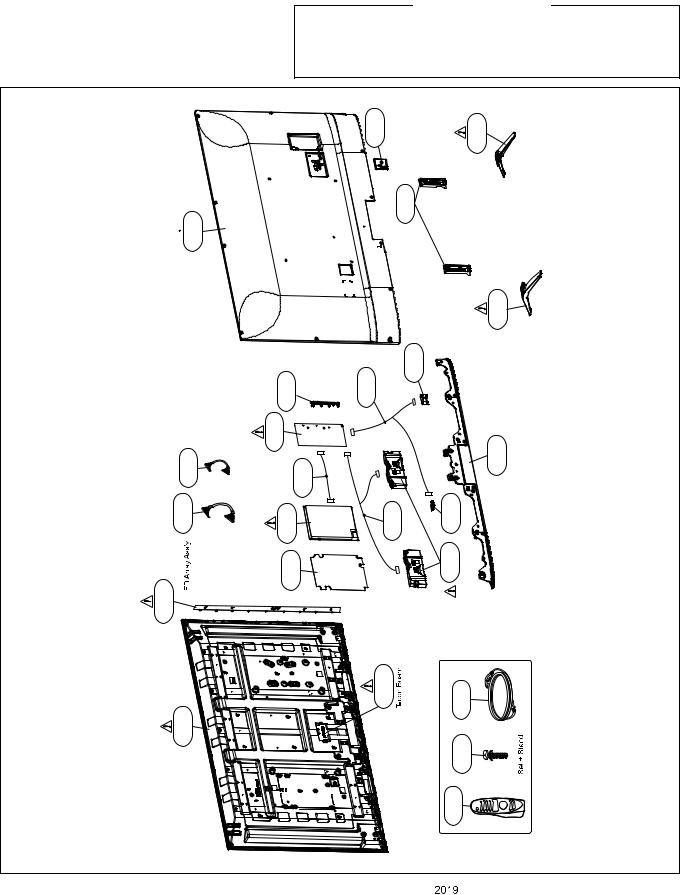
EXPLODED VIEW (SET)
IMPORTANT SAFETY NOTICE
Many electrical and mechanical parts in this chassis have special safety-related characteristics. These parts are identified by  in the EXPLODED VIEW.
in the EXPLODED VIEW.
It is essential that these special safety parts should be replaced with the same components as recommended in this manual to prevent Shock, Fire, or other Hazards.
Do not modify the original design without permission of manufacturer.
710 |
901 |
|
950 |
 400
400
|
|
|
902 |
|
521 |
HW1 |
570 |
LV2 |
540 HP1 |
|
411 |
LV1 |
530 |
HS1 |
500 |
200A |
820 |
|
120 |
200T |
700 |
200 |
A10 |
|
|
|
AR2 |
- 20 - |
Copyright © |
LG Electronics Inc. All rights reserved. |
|
Only for training and service purposes. |
|
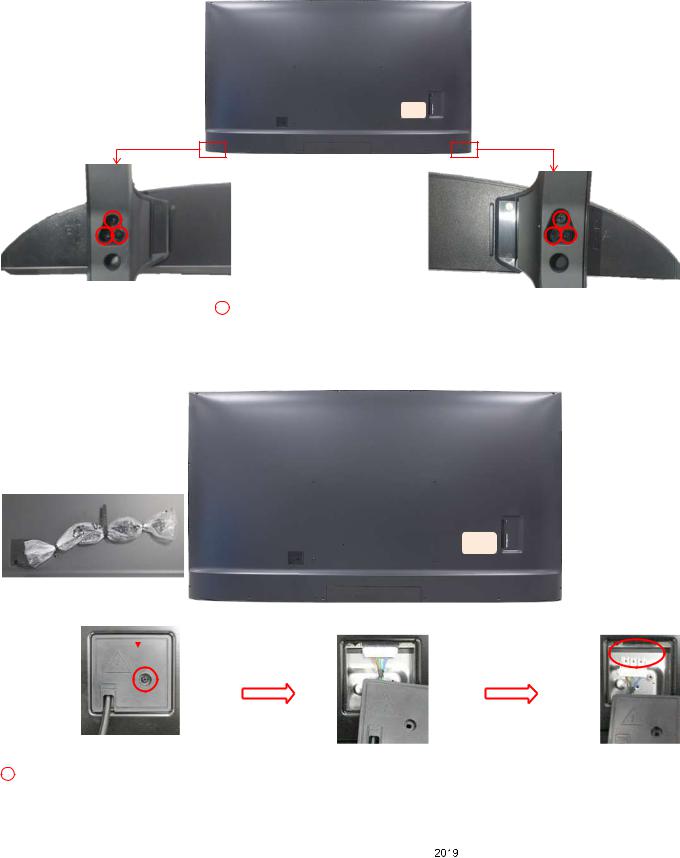
ASSEMBLY / DISASSEMBLY GUIDE
[Disassembly Guide]
(1) Lay the TV Set on a flat Pad and Remove the Stand Screw 6ea. (L:3ea / R:3ea) -> Remove the Stand Assy
: M4*30 6EA Disassemble screw
(2) Remove 1ea Screw of the Power Cord Bracket. -> Remove the Power Cord Bracket
|
|
|
|
|
|
|
|
|
|
|
|
|
|
|
|
|
|
|
|
|
|
|
|
|
|
|
|
|
|
|
|
|
|
|
|
|
|
|
|
|
|
|
|
|
:M3*5.5 1EA Disassemble screw |
Separate the Power Cord Bracket |
Remove the Power Cord Bracket Assy |
||||||
- 21 - |
Copyright © |
LG Electronics Inc. All rights reserved. |
|
Only for training and service purposes. |
|
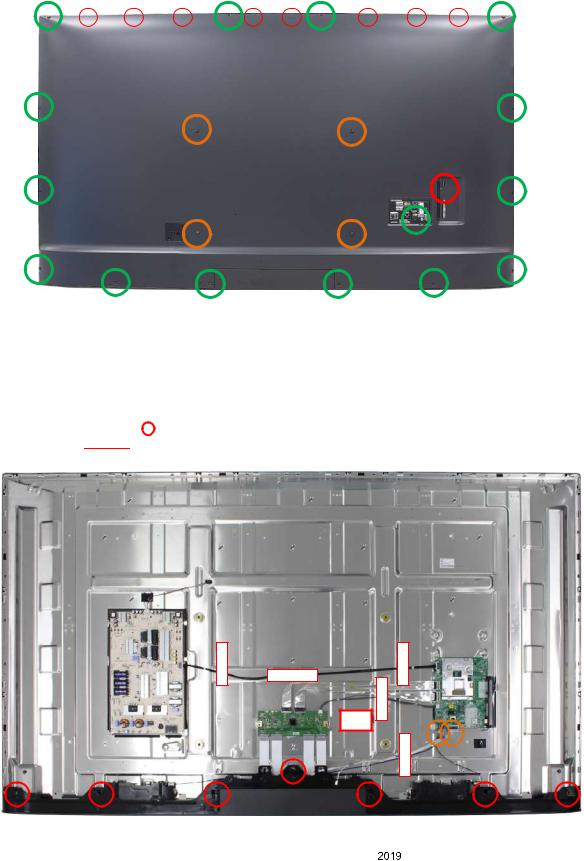
(3)Remove the B/C Screw 20ea. -> Remove the B/C
(Since there are Latches(8ea) on the upper side of B/C, you should disassemble from the bottom.)
 :M3*5.5 1EA Disassemble screw
:M3*5.5 1EA Disassemble screw
 :M4*10 15EA Disassemble screw
:M4*10 15EA Disassemble screw
 :M8*10 4EA Disassemble screw
:M8*10 4EA Disassemble screw  :Latch 8ea
:Latch 8ea
(4)M3*5.5 4ea Disassemble screw
(5)Detach the tape 3ea 

(6)Separate connector 1ea -> Remove the Bottom Cover Bracket 
|
|
|
(5) |
(5) |
|
|
|
|
(5) |
(5) |
|
|
|
|
|
|
|
|
|
|
(5) |
(5) (6)(6) |
|
|
|
|
(4) |
|
|
(4) |
(4) |
(4) |
(4) |
(4) |
(4) |
- 22 - |
Copyright © |
LG Electronics Inc. All rights reserved. |
|
Only for training and service purposes. |
|
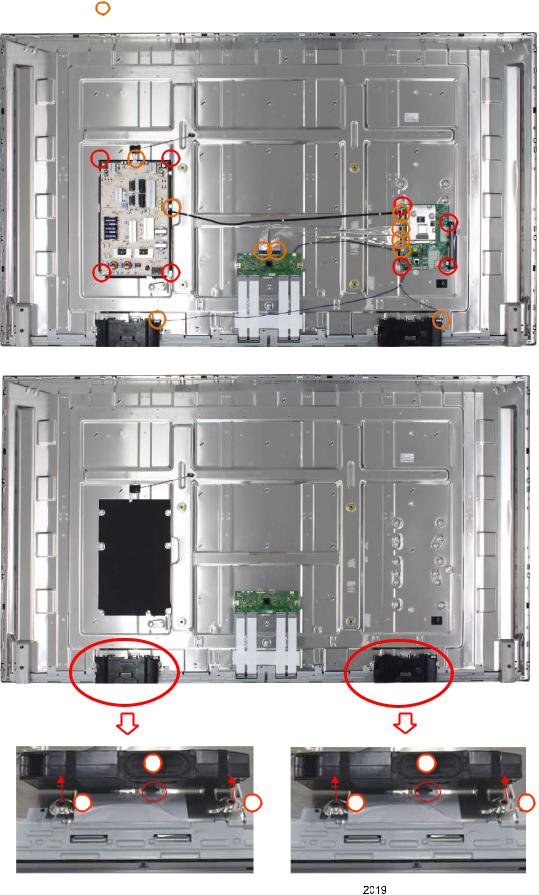
(7)Separate connector 10ea
(8)M3*5.5 8ea Disassemble screw -> Remove the Main and Power PCB Assy 
(8) |
(7) |
(8) |
|
|
|
|
|
(7) |
|
|
(8) |
|
|
|
|
(7) |
(8) |
|
|
|
|
|
|
|
|
(7) |
(7) |
(7) |
|
|
|
(7) |
|
||
|
|
|
|
(7) |
(8) |
(8) |
|
(8) |
|
(8) |
|
|
|
|
|||
|
|
|
|
||
|
|
(7) |
|
|
(7) |
(9) Remove the Speaker 2ea
b |
|
|
b |
a |
a |
a |
a |
- 23 - |
Copyright © |
LG Electronics Inc. All rights reserved. |
|
Only for training and service purposes. |
|
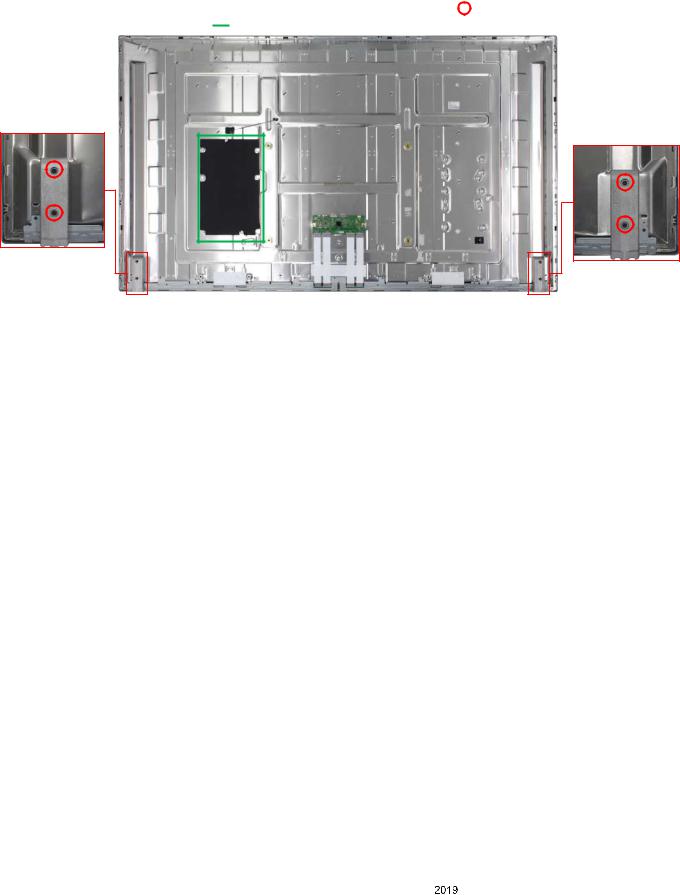
(10) M4*12 4EA Disassemble screw -> Remove the 2Pole Stand Guide Supporter(2ea) (11) Detach the Insulation Sheet 1ea 
- 24 - |
Copyright © |
LG Electronics Inc. All rights reserved. |
|
Only for training and service purposes. |
|
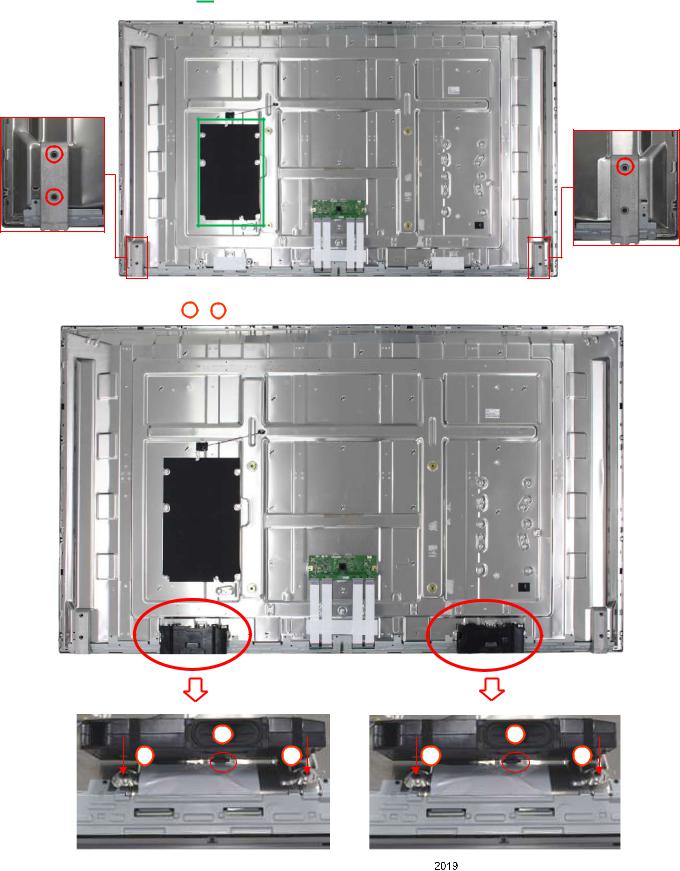
[Assembly Guide]
(1)Attach the Insulation Sheet 1ea 

(2)Place the 2Pole Stand Guide Supporter and M4*12 4EA Assemble screw 
|
(1) |
(2) |
(2) |
|
(2)
(2) 
(3) Assemble the Speaker 2ea. ( a |
b ) |
|
a |
|
a |
b |
b |
b |
b |
- 25 - |
Copyright © |
LG Electronics Inc. All rights reserved. |
|
Only for training and service purposes. |
|
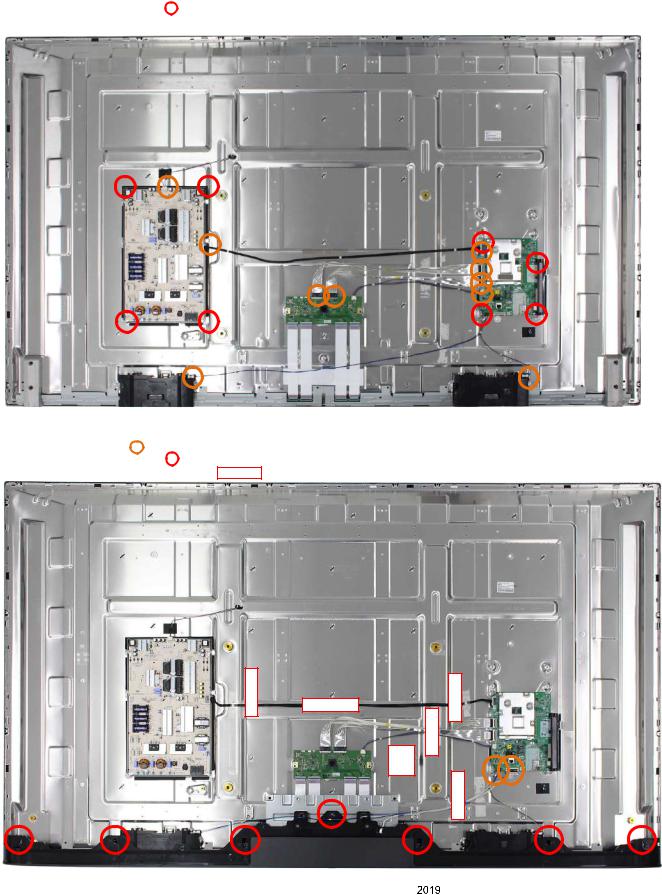
(4)M3*5.5 8ea Assemble screw
(5)Attach Connector 10ea 
(4) |
(5) |
(4) |
|
|
|
|
|
(5) |
|
|
(4) |
|
|
|
|
(5) |
(4) |
|
|
|
|
|
|
|
|
(5) |
(5) |
(5) |
|
|
|
(5) |
|
||
|
|
|
|
(5) |
(4) |
(4) |
|
(4) |
|
(4) |
|
|
|
|
|||
|
|
|
|
||
|
|
(5) |
|
|
(5) |
(6)Attach Connector 2ea
(7)M3*5.5 7ea Assemble screw
(8)Attach the tape (5ea) and Gasket (1ea)
|
|
|
(8) |
(8) |
|
|
|
|
|
|
|
|
|
|
(8) |
(8) |
|
|
|
|
|
|
|
|
|
|
(8) |
(8) (6) (6) |
|
|
|
|
|
|
|
|
|
|
(7) |
|
|
(7) |
(7) |
(7) |
(7) |
(7) |
(7) |
- 26 - |
Copyright © |
LG Electronics Inc. All rights reserved. |
|
Only for training and service purposes. |
|

(9)Since there are Latches(8ea) on the upper side of B/C, Assemble the Latches after cover the B/C.
(10)Assemble the B/C Screw 20ea.
 :M3*5.5 1EA Disassemble screw
:M3*5.5 1EA Disassemble screw
 :M4*10 15EA Disassemble screw
:M4*10 15EA Disassemble screw
 :M8*10 4EA Disassemble screw
:M8*10 4EA Disassemble screw  :Latch 8ea
:Latch 8ea
(11) Attach the Power Cord Bracket and Assemble the screw 1ea.
Attach the Power Cord Connector |
Assemble the Power Cord Bracket |
:M3*5.5 1EA Disassemble screw |
- 27 - |
Copyright © |
LG Electronics Inc. All rights reserved. |
|
Only for training and service purposes. |
|
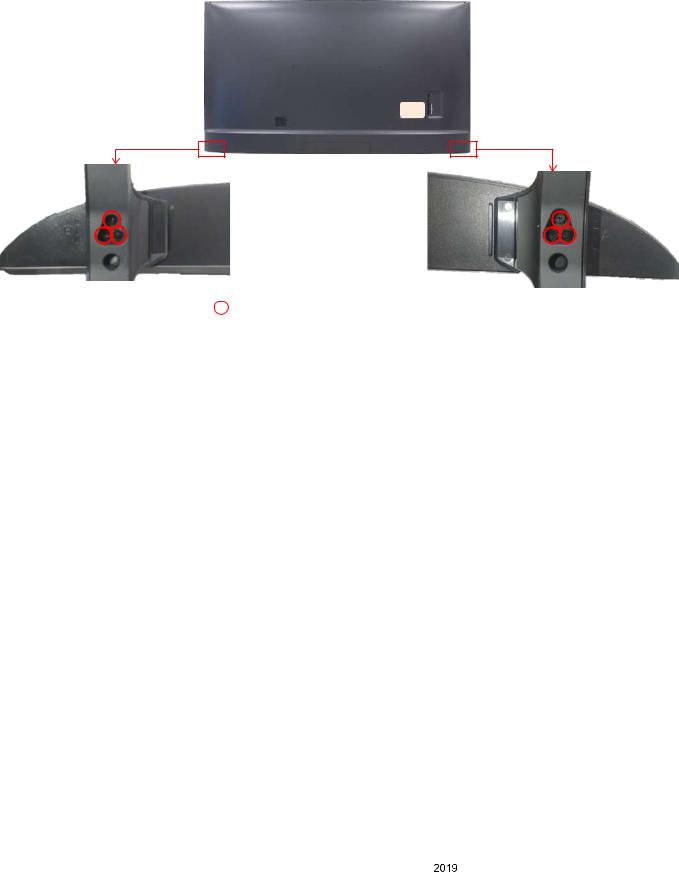
(12) Assemble the Stand Assy. (Assemble screw 6ea)
: M4*30 6EA Disassemble screw
- 28 - |
Copyright © |
LG Electronics Inc. All rights reserved. |
|
Only for training and service purposes. |
|

DISASSEMBLY GUIDE (MODULE)
(Step 1) Disassemble tthe Main, PSU, SPK, Wifi, IR & Stand Bracket A,B
(Step 2) Disassemble the S-PCB Cover Shield (left/right).
* Rear Sliver screw (left : 6-point / right : 6-point)
(Step 3) Reverse the LCM and disassemble the Source PCB from Holder
(Step 4) Disassemble the Case Top Screw (side) and Case Top
*top 10ea / side L 6ea / side R 6ea / down 10ea
- 29 - |
Copyright © |
LG Electronics Inc. All rights reserved. |
|
Only for training and service purposes. |
|

(Step 5) Disassemble the Panel.
* Use a tape to fix the FFC
(Step 6) 6 Disassemble the guide panel.
* 6-piece Guide Panel (Top 2ea / Side 2ea / Down 2ea)
(Step 7) Disassemble the Optical Sheet/Diffuser Plate (DS, Prism on Prism, DP)
(Step 8) Disassemble the DPS, LED Array Fixer(pin), and the Reflector
*Rotate the DPS |
* Push the LED Fixer (6ea) |
|
to remove (23ea) |
||
|
- 30 - |
Copyright © |
LG Electronics Inc. All rights reserved. |
|
Only for training and service purposes. |
|
